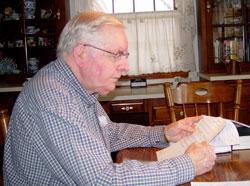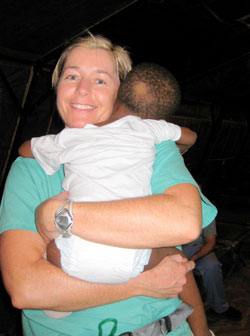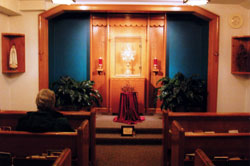Catholic News Around Indiana
Compiled by Brandon A. Evans
Diocese of Evansville
Genealogist has compiled family tree with nearly 75,000 names
 By MARY ANN HUGHES (Message staff writer)
By MARY ANN HUGHES (Message staff writer)
When he was a young boy, Mel Schapker would listen as his parents talked about their families. Their aunts, their uncles and their cousins. And sometimes his mom and dad would talk about the relatives with religious vocations.
Now that he’s in his seventies, he’s spending a lot of time documenting the lives of those relatives — and thousands of others.
About 25 years ago, he began to take a serious look at his family tree, and over the years he has gathered nearly 75,000 names. Not all of those names are his blood relatives; some are in-laws and their families too.
Back in 1986, he bought his first computer. It was an IBM and he smiles as he remembers how limited its space was.
In those early days of his family tree work, he started with immediate family members, and then looked at church records in Evansville, Haubstadt, Elberfeld and Newburgh. Eventually, his search expanded to parishes in towns such as Biblis, Darmstadt and Worms, Germany.
One of the things he has discovered during his 25-year quest is the large number of extended family members who were priests, deacons and religious sisters.
He found 61 priests, men with last names like Bastnagel, Brenner, Dewig, Endress, Erbacher, Foster, Gries, Herr, Kissel, Knapp, Koch, Niehaus, Reis, Reising, Schmitt, Steckler and Zenthoefer.
He discovered links to 12 deacons in the Diocese of Evansville including Deacon Francis Hillenbrand and the three Seibert men, Deacon Joseph, Deacon David and Deacon Michael.
He found 54 women religious in his research, sisters at both the Benedictine monastery in Ferdinand and at the Franciscan monastery in Oldenburg, Ind.
Their last names include Beckerle, Dewig, Elpers, Emmert, Gansman, Kercher, Maurer, Miller, Mueller, Preske, Raben, Rietman, Scheller and Seib.
He credits others for helping him compile all the names, including Father David Nunning, now pastor at St. Agnes and Sacred Heart churches in Evansville, who has also done extensive family tree research.
Photo caption: Mel Schapker studies family tree information that he has compiled over the last 25 years. (Message photo by Mary Ann Hughes)
(For these stories and more news from the Diocese of Evansville, log on to the website of The Message at www.themessageonline.org)
Diocese of Fort Wayne-South Bend
Health problems are only beginning in Haiti
 By Diane Freeby
By Diane Freeby
SOUTH BEND — Three months after a 7.0 earthquake decimated much of the already-impoverished country of Haiti, the thousands of people left injured and without homes are still very much in need of help. Ann-Marie Thomas, a South Bend nurse who returned from serving in Haiti last month, believes the health problems are only beginning.
“They’ve only now just started getting into when the disease sets in,” says Ann-Marie, who worked with a group of 17 medical volunteers from South Bend. “They’re thinking typhoid, cholera, tuberculosis are all going to come. There isn’t a chance these things won’t come, because they will. How many more will that affect?”
Over 200,000 people were killed in the Jan. 12 quake, including the Archbishop of Port-au-Prince. The capital city was leveled, families were ripped apart, millions left homeless and thousands were injured. Many had limbs amputated without the benefit of anesthesia, and according to Ann-Marie, infection is a major concern. One of her jobs was to teach patients to care for their wounds as they recover, not knowing when the next doctor might be available. Some patients have pins holding bones together, and those pins will need to remain in place for another two-to-three months.
“You have to keep that clean,” explains Ann-Marie. “I had peroxide wipes in little baggies that I was giving out. You just hope the next person will continue the care. They are totally at the mercy of whoever comes next.”
Ann-Marie spent five days serving in the village of Milot, about 75 miles north of Port-au-Prince. The Hopital Sacre Coeur is the only hospital left standing, and the 70-bed facility was flooded with over 400 patients. Ann-Marie spent much of her time dressing wounds and tending to the emotional as well as the physical needs of the people.
Photo caption: Ann-Marie Thomas holds the baby who was transported by helicopter into the hospital. At press time, Today’s Catholic learned that the child was reunited with his biological mother after his photo was featured in the Wall Street Journal.
True Presence felt in Eucharistic adoration
 By Kay Cozad
By Kay Cozad
FORT WAYNE — “No where on earth are you more welcomed, no where on earth are you more loved, than by Jesus, living and truly present in the Most Blessed Sacrament. … He is really there in person waiting just for you.” — Mother Teresa of Calcutta
The worship of the Eucharist outside of Mass has been an act of reverence for centuries in the Catholic faith and grew out of the teachings of the early Apostles. The reservation and adoration of the Blessed Sacrament during early Church history led Pope Clement VIII to issue a document establishing a devotion of 40-hours of prayer in 1592. The practice spread throughout the Catholic population and soon included perpetual adoration, or continuous adoration before the Eucharist.
Currently in the Diocese of Fort Wayne-South Bend many parishes offer opportunities to spend quiet time in the True Presence of Jesus Christ in the Blessed Sacrament.
One parish, St. Jude, Fort Wayne, offers a perpetual adoration chapel that has been open for continuous prayer for a quarter of a century and clocked over a million prayer hours. Ed Dahm, lifelong parishioner there, says adoration began as a Lenten observance in the parish in 1983. “We had adoration during Lent and invited several parishes to participate. It was a success,” he says.
He and several of the adorers spoke of instituting perpetual adoration at their parish and began to research the possibility. “Father (John) Pfister was for it,” he says. And by October of 1985 St. Jude became one of the few parishes in northern Indiana to offer perpetual adoration. Initially adorers were recruited from pulpit talks given by the priest. “People were asked to fill the time slots,” says Dahm, adding that “572 people signed up!”
Photo caption: Adorers pray during perpetual adoration at St. Jude’s Adoration Chapel in Fort Wayne. The chapel is open 24 hours each day all year long.
(For these stories and more news from the Diocese of Fort Wayne-South Bend, log on to the website of Today’s Catholic at www.todayscatholicnews.org)
Diocese of Gary
Serving multiple parishes: ‘It’s about who we are’
Story by Steve Euvino
MERRILLVILLE — The ongoing shortage of priests in the U.S. Catholic Church has resulted in changes, with multiple-parish pastoring the most common solution. While one priest for two or more parishes poses challenges, it also sets the stage for personal and spiritual growth for clergy and laity alike.
Kate Wiskus, an educator and author, shared that message with priests of the Diocese of Gary at a meeting March 11 at Ss. Peter and Paul.
Calling herself a “person in the pew,” Wiskus related information contained in “Pastoring Multiple Parishes,” a book she co-authored with Mark Mogilka, director of stewardship and pastoral services for the Diocese of Green Bay, Wis.
While interviewing priests serving multiple parishes, Wiskus and Mogilka found that clergy were tired from the extra duties, and yet priests also found the good coming from the situation.
Serving more than one parish did not negatively affect their sense of priestly ministry, the co-co-authors found. Rather, Wiskus said, this extra duty “amplified their sense of ministry.”
An associate dean of formation at the University of St. Mary of the Lake, Mundelein Seminary, Wiskus pointed to a movement away from “it’s about me” to “it’s about Christ” as clergy and laity adjusted to serving multiple parishes.
Father Gerald Schweitzer, pastor of three parishes in LaPorte County, said that over the past four years “we’re developed a great ministry among the three parishes. It’s about who we are.”
Wiskus noted that from her research, “each priest felt blessed to have been called to that particular ministry.” Wiskus said that as priests recognized “they were being built up, as well as the people. It was a tremendous sign of the Holy Spirit.”
Priests serving multiple parishes are nothing new, Wiskus and Mogilka state in their book. According to the Center for Applied Research in the Apostolate, as early as 1965 this country had 549 parishes (3 percent of the U.S. total) without a resident priest. What is new, the writers state, is the growth of this practice.
(For this story and more news from the Diocese of Gary, log on to the website of the Northwest Indiana Catholic at www.nwicatholic.com)
Diocese of Lafayette
FOCUS conference leaves lasting impact on college students
By Louisa J. Reese
MUNCIE — The 2010 Fellowship of Catholic University Students Conference promised students five days that would change their relationship with God and others.
Jill Pitcher, FOCUS team director at Ball State University, said 41 Ball State students and 10 others who traveled with them walked away with a changed perspective of God and the Church.
The conference was held Dec. 30 to Jan. 3 in Orlando. The theme was “Made for More.”
Pitcher and three other missionaries introduced FOCUS to the Ball State campus and St. Francis of Assisi Parish in the fall of 2008.
The team’s goal is to evangelize students through small- group Bible studies and one-on-one mentoring or discipleship. Other missionaries at Ball State University this year are Mark Joseph, Ross Hornsby and Clare Kummant.
Curtis Martin founded the ministry for Catholic college students in 1998. Today, the organization is present in more than 20 states.
The 2010 FOCUS conference included the opportunity for 24-hour adoration, daily Mass, talks, prayer and fellowship, plus two concerts.
“The night of Eucharistic adoration, on Jan. 1, called the ‘Night with Our Lord,’ was one of the most pivotal nights we had during conference,” Pitcher said.
During that time, 75 priests administered the sacrament of reconciliation for nearly four hours and heard an estimated 2,500 confessions.
“It was absolutely a beautiful and grace-filled time,” Pitcher said, “and the students loved it, because it was the point in time when most of them had a conversion of heart or a very deep and powerful experience of the Eucharist. Our Lord poured out his grace during that time and the students responded.
“What struck me the most was seeing the growth of the FOCUS conference. At my first conference, six years ago, there were only about 1,300 students. (This time), there were 4,000.”
On the Ball State campus last year, 10 small-group Bible studies were attended by approximately 60 students every week, Pitcher said. This year, 20 Bible studies are attended by approximately 120 students. Fourteen of the studies are led by student disciples.
Fast for a day filled with lessons for a lifetime
By Caroline B. Mooney
LOGANSPORT — “Live simply so that others may simply live.”
That is what 52 middle-school and high-school students from eight parishes of the Logansport Deanery did during a food fast, from 7 p.m. Feb. 27 to 7 p.m. Feb. 28 at All Saints Church here. Participants had only juice and water.
“Our youth need to see why giving to the poor is important,” said Sylvia Downing, director of religious education at St. Joseph Church, Reynolds. “This 24-hour period was to give them just that, an opportunity to live as the poor while learning more and doing service work for the less fortunate.”
It was a jam-packed 24 hours. Upon arrival, the students had to give up their cell phones. Everyone was allowed to bring a sleeping bag, pillow and a large box to sleep on. Only personal items that could fit into a gallon-sized plastic bag were allowed.
There was prayer, games, and a talk from a soup kitchen worker in Monticello. Small groups then talked about fasting, journaled, played more games and prayed again, then slept on the gym floor.
Sunday morning, a couple who have made several trips to Haiti spoke of the enormous poverty in that country. Next, everyone played “The Poverty Game,” in which players were given real-life scenarios that showed how poverty could befall anyone.
Downing had participated in a similar fast in another diocese and suggested it to the directors of religious education in Logansport Deanery parishes. They used Catholic Relief Services’ “Face the Fast,” a hunger awareness program for youth in the United States, and tailored it to their own needs. The program took the place of the often-used CRS rice bowls.
“I hope that the kids understand the next time they see someone walking or who is without a job that circumstances are not always something we can control,” said Teresa Keay, formation coordinator at All Saints Church. “When the couple spoke about Haiti, they said even though one person can make a difference, together we can really make a big difference. And, together we can always pray.”
Local Church members respond in Haiti: 'I felt the Holy Spirit flying around those tents ...'
By Kevin Cullen
WEST LAFAYETTE — Members of a medical team that just returned from Haiti say they will never forget the woman who gave birth while trapped in rubble … and broken bones that went untreated for a month … and homeless, penniless earthquake survivors who were thankful to be alive.
“They always thank you so much,” said Mindy Clayton, a registered nurse who attends the Cathedral of St. Mary of the Immaculate Conception, Lafayette. “When you leave, you want to thank them for their strength, their spirit, and what they give us. They just fill my soul with happiness. This whole experience has really brought me into the spirit of Lent.”
She was among four nurses, four physicians and a nurse practitioner brought together by Jane Sellers, a parishioner at St. Thomas Aquinas Church, on the Purdue University campus. They returned to Indiana Feb. 12 after working for a week at St. Damiens Hospital for Children, just outside Port-au-Prince, and serving adult patients in tents pitched nearby.
The volunteers “jumped on this trip so quickly. I was blown away,” said Sellers, who has made many mission trips to Haiti with her husband, Duane.
The team provided post-operative care to some patients who had undergone surgery aboard the U.S.S. Comfort, an American hospital ship. Others had injuries that had gone untreated since the Jan. 12 disaster that killed at least 200,000 people.
The St. Damiens campus was set up to accommodate the needs of trauma patients of all ages. Volunteers from Haiti, Germany, Italy, the United States and other countries worked together.
“It was like a MASH unit,” Clayton said.
Approximately 80 percent to 90 percent of the injuries were caused by crushing. Truckloads of victims were still being brought in with broken bones; others had had limbs amputated, and needed follow-up care because of infection.
“I felt the Holy Spirit flying around those tents, and that my guardian angel was on my shoulder,” she said. “When we couldn’t find things, they showed up.
“I had one lady who had lost all her children, her husband, her mother and father. She was the only one living in the family,” Clayton said.
But despite all that, “she knew she was saved by God. She felt that God had saved her to do something special. I thought, ‘What a way to look at it.’
“For 200 years, they have said, ‘Here I am again. It will all work out again.’”
(For these stories and more news from the Diocese of Lafayette, log on to the website of The Catholic Moment at www.thecatholicmoment.org)
 By MARY ANN HUGHES (Message staff writer)
By MARY ANN HUGHES (Message staff writer) By Diane Freeby
By Diane Freeby By Kay Cozad
By Kay Cozad